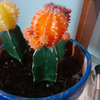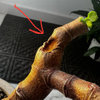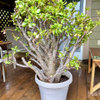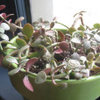Coccinia quinqueloba: Monoecious or Dioecious?
15 years ago
I am curious whether anyone knows whether Coccinia quinqueloba is monoecious or dioecious--are both male and female flowers on one plant or are they on separate plants?
I don't know whether C. quinqueloba is considered a caudiciform--it is a tuberous cucurbit. The more common C. grandis is grown as a caudiciform and is dioecious--two plants needed to produce fruit. Looking for info on C. quinqueloba I did notice at least one other species in the genus was monoecious (only need one plant to produce fruit).
Both C. quinqueloba and C. grandis are referred to as "Ivy Gourd". As you may guess from the name, the leaves of C. quinqueloba are 5-lobed.
Here's an article on C. grandis (I'm sure there are many, this is just the first I found):
http://www.bihrmann.com/caudiciforms/subs/coc-gra-sub.asp
And here's the page from the nursery I bought the plant from (they're not sure about the one vs. two sex business):
http://www.anniesannuals.com/plants/plant_display.asp?prodid=1214&account=none
I mostly bought the plant for the fruits, which I've only seen in this picture. I'm hoping I can get this fruit from just my one plant!
Any other info on this plant would also be appreciated.




joscience
mark4321_gwOriginal Author
joscience
mark4321_gwOriginal Author
mark4321_gwOriginal Author
joscience